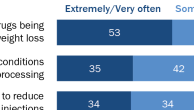The Information Therapy conference just ended on Friday and my head is buzzing with a few favorite moments:
1) Josh Seidman‘s speech connecting our venue, the Newseum, to his mission by talking about the history of the U.S. press, mail system, and medicine: the Pony Express was viewed as so democratic that it was almost subversive.
2) Bill Kormos talking about Mass General’s program for snail-mailing(!) VHS and DVD informed-decision-making videos. Dr. Kormos said it has been a challenge to get doctors to tell patients about them. I suggested that they put all the videos up on YouTube and let patients and their families drive the demand, but it turns out all the content is proprietary. Too bad — the advanced directive one sounds interesting.
3) Carolyn Pare bluntly saying that we should not only look at health policy, but agriculture policy and tax policy — there are many forces at work to create this health crisis.
4) David Bradley‘s personal story about tracking down the answer to his mysterious ailment thanks to an obscure e-patient community site (after spending big bucks on research and consultations up and down the East Coast).
5) Neil Calman‘s prediction that internet access will continue to penetrate the underserved community as Latino and African immigrants go online to keep in touch with relatives back home.
This was especially important for me to hear since my remarks focused on Josh Seidman’s question, “Are people ready for patient-centered health IT?” The answer is yes, with an asterisk.
I talked about how there are pockets of non-internet users, just as there are pockets of people who do not have a home phone. As Penn State scholar Jorge Reina Schement wrote in 1996, and it is still true today: “Isolation is not distributed randomly; rather, it is concentrated in certain groups so that they suffer its consequences with intensity.”
In addition to the classic low-access demographics, health status is also a significant factor in predicting internet use. If we included living with a chronic condition in the thermometer of access, that group would fall at around the 50% mark, whereas adults with no disability or chronic illness fall around the 75% mark.
And yet, once online, people living with chronic conditions are just as likely to use the internet to gather and share health information as other internet users. A serious diagnosis can be a factor in low access to technology, but not necessarily low interest in health information.
Join the discussion at e-patients.net.




